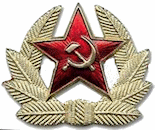The Soviet Army
 The RKKA, or Red Army of Workers and Peasants, which emerged during the Civil War, relied heavily upon tsarist military specialists for combat leadership, staffing, and training. The Great Patriotic War (1941-1945) became for the ground forces an exceptionally difficult test. All the most important combat missions in the fight with the Fascist-German aggressors - a cruel, experienced and strong enemy - were solved, first of all, by ground forces. In the course of the war the ground forces underwent significant development. The growth of their fire and assault power, maneuverability and combat efficiency occurred on the base of the introduction of the new, more effective weapon systems and combat materiel, increase in the combat experience of troops, acquisition of craftsmanship by executive body and improvement of means and methods of control. All this led to the fact that ground forces in the years of war became first-class on their armament, unsurpassed due to the morale and quite advanced on the skill of conducting combat operations.
The RKKA, or Red Army of Workers and Peasants, which emerged during the Civil War, relied heavily upon tsarist military specialists for combat leadership, staffing, and training. The Great Patriotic War (1941-1945) became for the ground forces an exceptionally difficult test. All the most important combat missions in the fight with the Fascist-German aggressors - a cruel, experienced and strong enemy - were solved, first of all, by ground forces. In the course of the war the ground forces underwent significant development. The growth of their fire and assault power, maneuverability and combat efficiency occurred on the base of the introduction of the new, more effective weapon systems and combat materiel, increase in the combat experience of troops, acquisition of craftsmanship by executive body and improvement of means and methods of control. All this led to the fact that ground forces in the years of war became first-class on their armament, unsurpassed due to the morale and quite advanced on the skill of conducting combat operations.
The victories, gained near Moscow and Leningrad, Stalingrad and Kursk, in Ukraine, in Belorussia and Baltic States, led to the final mastery of strategic initiative and the release of Soviet territory from the aggressors. As a result of further rapid offensive the basic groups of Fascist troops on the Vistula, Danube and Oder were destroyed, which led to the victorious completion of war in Europe, while subsequently also in the Far East. In combat with the Fascist-German aggressors and the Japanese militarists the soldiers and the officers of ground forces showed themselves by fearless and courageous soldiers, appeared the models of striking durability, resourcefulness and bravery.
Impelled by economic, political, and even military considerations, in 1988 the Soviets embraced the concept of "defensiveness" in their military doctrine. They admitted that defensiveness contradicted and altered what had in reality been a long-standing offensive orientation in the component levels of Soviet military science - strategy, operational art, and tactics. They underscored their sincerity by proposing to create a new military force structure, which by its very nature had to be construed by the West as defensive.83 However, as the shape and form of the new Soviet force structure emerged, it became clear that there was a sharp dichotomy between the offensively oriented force so evident in Soviet writings up to and through 1985 and the new and apparently defensive force being implemented. In essence the former force, offensive in its orientation, seemed to accord with strictly military requirements, while the new defensive structure reflected the dictates of sharply adverse economic and political conditions.
During the period 1988 through 1991, political and economic realities prompted the Soviets to enunciate a new defensive military doctrine within the context of the twin programs of perestroika and glasnost'. The central notion of defensiveness was a Soviet commitment to a strategic defensive posture based upon the principle of "defensive sufficiency" and a military strategy based upon premeditated defense. Driven by political and economic necessity, the Soviets shelved their attempts to restructure their armed forces to meet the demands of nonlinear war and temporarily abandoned public attempts to create a corps, brigade, and combined-arms force structure that could fight and survive in the fragmented modern battlefield. While doing so, however, both the economic situation within the Soviet Union and the technological dilemmas that the Soviet Army faced worsened sharply.
In accordance with defensiveness, the Soviets introduced two new divisional structures. The first, called Division 89, fielded in the forward groups of forces, was clearly defensive in nature. The new square, motorized rifle division consisted of four motorized rifle regiments and incorporated the combined-arms principle by including a tank battalion in each motorized rifle regiment. The new tank division had two tank and two motorized rifle regiments. However, both divisions were far weaker than their predecessors, and they suited political rather than military needs. The second type formation, called Division 90, and formed within the depths of the Soviet Union, was a stronger counteroffensive-type shock division. To a greater extent, these divisions were better tailored to suit their prospective combat function and the area in which they operated.
At the same time, the Soviets revived the fielding of fortified regions (ukreplenniye raiony) as economy-of-force military formations. Although Division 90 formations realistically met military demands, they were "cumbersome and expensive," and they experienced "serious complexities in rear services and technical support." Nevertheless, they represented serious efforts by Soviet military authorities to satisfy both the requirements of defensiveness, military-technological realties, and the perceived demands of future war.
|
NEWSLETTER
|
| Join the GlobalSecurity.org mailing list |
|
|
|

